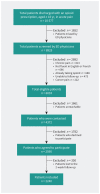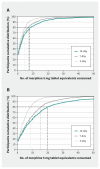Opioid prescribing requirements to minimize unused medications after an emergency department visit for acute pain: a prospective cohort study
- PMID: 39009368
- PMCID: PMC11268147
- DOI: 10.1503/cmaj.231640
Opioid prescribing requirements to minimize unused medications after an emergency department visit for acute pain: a prospective cohort study
Abstract
Background: Unused opioid prescriptions can be a driver of opioid misuse. Our objective was to determine the optimal quantity of opioids to prescribe to patients with acute pain at emergency department discharge, in order to meet their analgesic needs while limiting the amount of unused opioids.
Methods: In a prospective, multicentre cohort study, we included consecutive patients aged 18 years and older with an acute pain condition present for less than 2 weeks who were discharged from emergency department with an opioid prescription. Participants completed a pain medication diary for real-time recording of quantity, doses, and names of all analgesics consumed during a 14-day follow-up period.
Results: We included 2240 participants, who had a mean age of 51 years; 48% were female. Over 14 days, participants consumed a median of 5 (quartiles, 1-14) morphine 5 mg tablet equivalents, with significant variation across pain conditions (p < 0.001). Most opioid tablets prescribed (63%) were unused. To meet the opioid need of 80% of patients for 2 weeks, we found that those experiencing renal colic or abdominal pain required fewer opioid tablets (8 morphine 5 mg tablet equivalents) than patients who had fractures (24 tablets), back pain (21 tablets), neck pain (17 tablets), or other musculoskeletal pain (16 tablets).
Interpretation: Two-thirds of opioid tablets prescribed at emergency department discharge for acute pain were unused, whereas opioid requirements varied significantly based on the cause of acute pain. Smaller, cause-specific opioid prescriptions could provide adequate pain management while reducing the risk of opioid misuse.
Trial registration: ClinicalTrials.gov, no. NCT03953534.
© 2024 CMA Impact Inc. or its licensors.
Conflict of interest statement
Competing interests:: Justin Yan reports receiving funding from the Spring 2021 Innovation Fund from the Academic Medical Organization of Southwestern Ontario, and the 2021 Internal Research Fund for Pilot Studies from the Lawson Health Research Institute. Dr. Yan has also served as the chair of the data safety monitoring boards of the RAFF4 Study and the REMOSYNCED Study, and vice-chair of the Canadian Association of the Emergency Physicians Research Committee. Jeffrey Perry reports receiving a peer review salary support grant from the Heart and Stroke Foundation of Ontario. Gilles Lavigne reports receiving consulting fees from Straumann Suisse related to a sleep bruxism device, and an oral appliance for sleep apnea from Panthera Dental. Dr. Lavigne is also a board member of the Canadian Academy of Health Sciences. No other competing interests were declared.
Figures





Similar articles
-
Quantity of opioids consumed following an emergency department visit for acute pain: a Canadian prospective cohort study.BMJ Open. 2018 Sep 17;8(9):e022649. doi: 10.1136/bmjopen-2018-022649. BMJ Open. 2018. PMID: 30224393 Free PMC article.
-
Effect of Changing Electronic Health Record Opioid Analgesic Dispense Quantity Defaults on the Quantity Prescribed: A Cluster Randomized Clinical Trial.JAMA Netw Open. 2021 Apr 1;4(4):e217481. doi: 10.1001/jamanetworkopen.2021.7481. JAMA Netw Open. 2021. PMID: 33885773 Free PMC article. Clinical Trial.
-
Accuracy of a self-report prescription opioid use diary for patients discharge from the emergency department with acute pain: a multicentre prospective cohort study.BMJ Open. 2022 Oct 28;12(10):e062984. doi: 10.1136/bmjopen-2022-062984. BMJ Open. 2022. PMID: 36307159 Free PMC article.
-
Prescription Opioid Use for Acute Pain and Persistent Opioid Use After Gynecologic Surgery: A Systematic Review.Obstet Gynecol. 2023 Apr 1;141(4):681-696. doi: 10.1097/AOG.0000000000005104. Epub 2023 Mar 9. Obstet Gynecol. 2023. PMID: 36897135
-
Evaluation of Interventions to Reduce Opioid Prescribing for Patients Discharged From the Emergency Department: A Systematic Review and Meta-analysis.JAMA Netw Open. 2022 Jan 4;5(1):e2143425. doi: 10.1001/jamanetworkopen.2021.43425. JAMA Netw Open. 2022. PMID: 35024834 Free PMC article.
Cited by
-
How Does Self-Declared Chronic Pain Compare to Other Definitions? A Prospective Multicenter Study.Pain Res Manag. 2025 Jun 19;2025:5556400. doi: 10.1155/prm/5556400. eCollection 2025. Pain Res Manag. 2025. PMID: 40575042 Free PMC article.
-
Preventing harms from first prescriptions of opioids.CMAJ. 2025 Feb 9;197(5):E133-E134. doi: 10.1503/cmaj.250094. CMAJ. 2025. PMID: 39929493 Free PMC article. No abstract available.
-
Prévention des méfaits dès la première prescription d’opioïdes.CMAJ. 2025 Apr 13;197(14):E400-E402. doi: 10.1503/cmaj.250094-f. CMAJ. 2025. PMID: 40228841 Free PMC article. French. No abstract available.
-
Preventing opioid prescribing for low back pain using multimodal mechanical stimulation vs. TENS: a randomized-controlled trial.Front Pain Res (Lausanne). 2025 Jul 10;6:1612572. doi: 10.3389/fpain.2025.1612572. eCollection 2025. Front Pain Res (Lausanne). 2025. PMID: 40709052 Free PMC article.
-
Impact of the COVID-19 pandemic on opioid toxicity mortality rates in Nova Scotia: An interrupted time series analysis (2009-2023).Can J Public Health. 2025 Aug 6. doi: 10.17269/s41997-025-01092-8. Online ahead of print. Can J Public Health. 2025. PMID: 40768024
References
-
- Drug overdose death rates. Bethesda (MD): National Institute on Drug Abuse; 2023. Available: https://nida.nih.gov/research-topics/trends-statistics/overdose-death-rates (accessed 2023 Nov. 23).
-
- Opioid- and stimulant-related harms in Canada. Ottawa: Public Health Agency of Canada; modified 2024 Mar. 27. Available: https://health-infobase.canada.ca/substance-related-harms/opioids-stimul... (accessed 2023 Nov. 23)
Publication types
MeSH terms
Substances
Associated data
LinkOut - more resources
Full Text Sources
Medical
